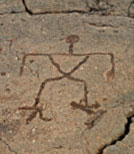Volcanoes have their own language and here in Hawai`i, even their own goddess. Visitors are sure to hear stories of Pele, the fire goddess of volcanoes; discover the difference between ‘a‘ā (sharp, brown) and pāhoehoe (smooth, black) lava; drive past cinder cones and pu‘u formations; and view spatter ramparts, lava tubes and caves, and crustal overturnings by the side of the highway.
Why so much variation in the look and texture of our lava fields? “All Hawaiian lava is black when it first cools but may turn more brownish as the iron in the lava oxidizes with rain and time,” says James Kauahikaua, a geophysicist with the USGS Hawaiian Volcano Observatory. “The type of lava — ‘a‘ā or pāhoehoe — is the result of sheer stresses within the liquid lava while it is flowing. Higher eruption rates characteristic of the early days of an eruption usually produce ‘a‘ā lava, whereas lower eruption rates usually produce pāhoehoe lava. There is no substantial difference in chemistry between the two forms of lava.”
The early Hawaiians made creative use of the dominant material they had on hand, using the lava rock to build boundary fences, pens for livestock, heiau (religious platforms), and fishpond seawalls among many things.
Adjacent to the fishponds fronting the Waikoloa Beach Mariott Resort & Spa, two rock structures (thought to have been constructed in the 1300s) were used for the highly structured, religious system of the Hawaiians. The men’s eating house, or Ka Hale Mua, is the larger of the two and consists of three rooms. Men visited to worship the gods and eat food together. Women were forbidden to eat with men in ancient Hawaiian times. The sleeping house, or Noa, is a one-room structure where men and women met freely and slept together.
In some areas, the pāhoehoe lava was used for carving petroglyphs, with some of the best of the state’s best petroglyph fields preserved within Waikoloa Beach Resort. With no written Hawaiian language, it is speculated that these rock carvings may be a sort of historical record of families, commemorations of significant events, or even astronomical symbols.
A tour of the Waikoloa petroglyph fields is offered every Thursday and Friday from 9:30 to 10:30 am (groups meet lakeside, next to Island Fish & Chips in Kings’ Shops).

